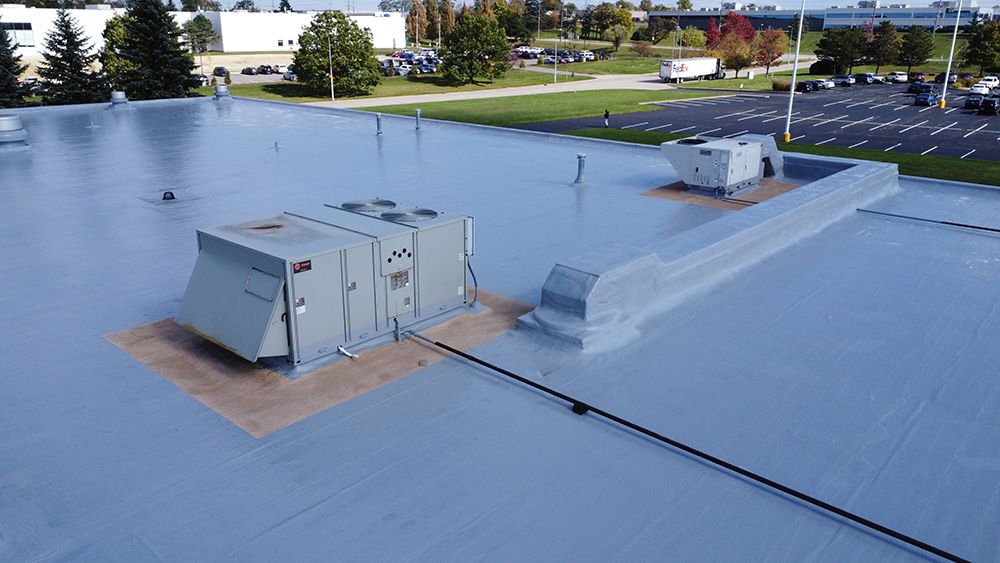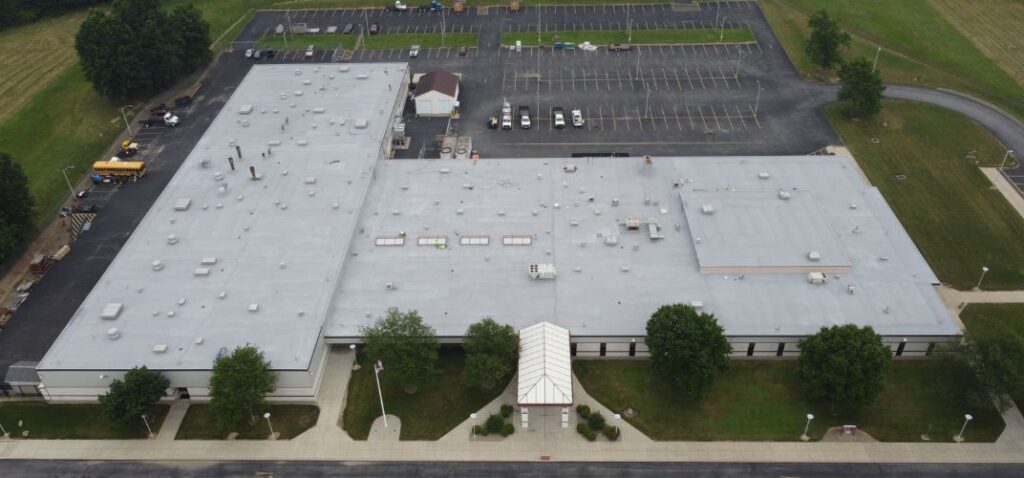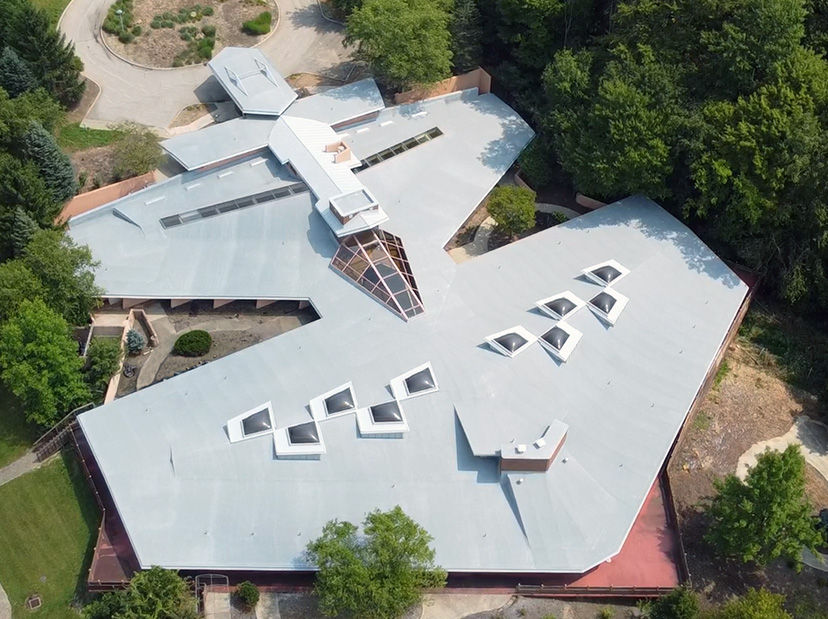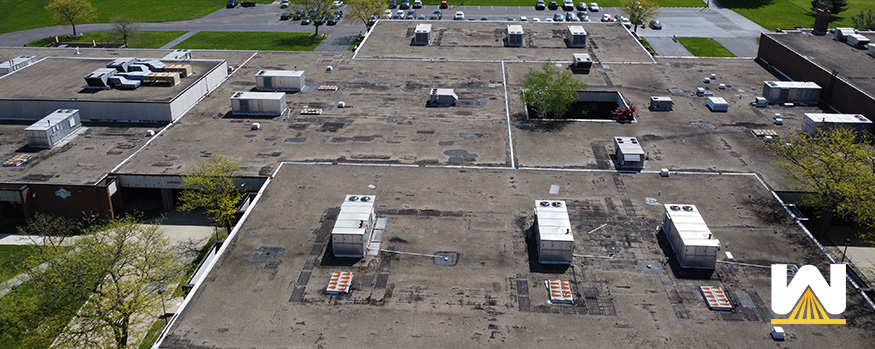Summary: The three mistakes building owners make with their roofs are:
- Avoiding maintenance. Eventually, the roof will have issues and could end up needing to be 100% torn off. A more cost-effective solution is to pay for maintenance and then restore it (not rip it off) when the warranty is over.
- Not considering all roofing systems. Some roof types (flat, few penetrations) might be more suited for a single-ply system such as TPO or EPDM. Other roofs with many penetrations, R-value concerns, sloping issues, and hard-to-locate leaks might be more suited for a fluid-applied roofing system, which they probably have never heard of before.
- Choosing the wrong contractor (or choosing the cheapest one.) Commercial roofs are not cheap. The quality of the install (and the trust/professionalism of the contractor) should be the most important part of the project. Having roofing issues in 2 years after you’ve spent thousands of dollars can create many avoidable (and costly) headaches.
As a building owner, you certainly have a lot of things to worry about:
- Collecting rent
- Making sure tenants don’t burn your building down
- Security
- Maintenance
And probably a hundred other things.
One thing you don’t want to do is make a mistake with your roof.
In this article, we’ll explain the summary of the three mistakes above in more detail.
And just so you’re aware, West Roofing Systems has been in commercial roofing since 1979. We know the mistakes building owners make. Whether that’s installing a roofing system that we do or not.
Here are the top mistakes to avoid that could be very costly to a building owner:

Mistake #1 – Avoiding maintenance
The biggest mistake building owners make with their roofs is not maintaining them. Neglecting the roof is very easy to do.
Eventually, something bad could happen to the roof; either it leaks or parts of it blow off. When this happens, in many cases, the roof is in too bad of shape for restoration.
Now the owner is forced to do a 100% tear-off and install a whole new roof.
This can be avoided with proper maintenance.
It’s really no different than doing maintenance for your car.
What would happen if you never changed the oil and the engine blew up?
The repair would probably be expensive. To the point where it made more sense to just buy another vehicle.
For a commercial roof:
- Getting the seams looked at to ensure they have proper adhesion is a way to ensure the roof doesn’t blow off one day.
- Looking at the fasteners to ensure they are still installed right is a way to make sure water doesn’t enter below.
- Checking for ponding/standing water ensures the roof has the proper slope to run water off the roof in time.
- Making sure drains and gutters aren’t clogged is a way to eliminate standing water.

What’s a scenario where this hurts the wallet?
Say you have a rubber roof that’s 15 years old. You’ve been maintaining it in the Spring and Fall since it was installed. The membrane is wearing out and the seams are slightly losing adhesion.
You can install a silicone roof coating system over the existing roof with minimal tear-off, if any. Since you’ve been maintaining your roof, you’ll likely have no tear-off.
Installing a coating system will get you a brand new 10-20-year warranty. Increase the roof’s reflectivity. And the warranty is renewable.
A roof coating system costs $3 – $7 per square foot. But since this roof is in good shape, preparation will be minimized. You could be on the lower end of the $3 – $7 spectrum. Keep in mind, these are ballpark numbers that can change based on many variables.
Let’s say maintenance costs $1000 per year for 15 years. And the coating system cost is high at $6 per square foot. Your roof is 20,000 sq. ft. Your 15-year total cost is $135,000.
Now, let’s say you have the same 15-year-old rubber roof.
You maintained it for the first few years but dropped the expense since there were no major problems.
In the year 15, the roof leaks, and there’s ponding water everywhere because drains are clogged. Tiny entry points have allowed water to enter the insulation, saturating it, and causing the roof to sag and have an improper slope.
This roof is in too bad of shape for restoration or a roof coating system.
The only option is a 100% tear-off, likely causing at least $10 per square foot. Think about all the tear-off, labor hours, transportation fees, and landfill fees that could’ve been avoided?
In this case, you did maintenance for 2 years ($2,000) and for your new roof, you’ll pay $10 per square foot x 20,000 square feet. This equals to $202,000.
This calculation was done with the highest price of a coating system and the lowest of a complete tear-off.
$135,000 vs $202,000.

Mistake #2 – Not considering all roofing systems
Some building owners only choose a roofing system they are familiar with, like TPO, Rubber, or Metal.
But in some cases, another roofing system could be a better product overall.
For example, a single-ply roof could be best on a wide-open roof with very few penetrations. The material is on the cheaper side than most roofing systems, and since there aren’t many penetrations, the install can happen without much interference.
On the flip side, if there’s a roof with lots of penetrations, a single-ply roof will take much longer (and cost more) to install than a fluid-applied roofing system, such as spray foam or a roof coating system.
Speaking of fluid-applied roofing systems, have you ever heard of them? Most have not.
Spray foam and roof coating systems provide a seamless membrane (no seams or fasteners to worry about), and their warranties are renewable.
Here’s a video of a spray foam roofing installation from start to finish:
Here’s a video of a roof coating system installation from start to finish:
Mistake #3 – Choosing an untrustworthy, wrong, or the cheapest contractor
Choosing the wrong contractor can be devastating. Imagine spending $100k with someone and the roof leaks in 2 years. They don’t answer the phone. The voicemail box is full. Lawyers are about to be involved.
Don’t put yourself in that position.
Many commercial roofing companies charge more than others because:
- They have good employees who have been installing roofing systems for decades
- They invest in training for their employees
- They invest in drug testing and safety equipment
- They have proper insurance, licensing, and are approved contractors of highly respected roofing material manufacturers
And probably more things that I can’t think of.
Here are some tips on choosing the right contractor:
- Make sure they have been around a while. A company with longevity doesn’t stick around by installing inferior roofs forever.
- Ensure they have experience doing a similar job to what you’re having done. For example, if they are installing coating over an existing TPO roof, make sure they have multiple references you can contact who have had the same work done.
- See if they are certified installers of the products they are about to install. A manufacturer doesn’t want a bad reputation by having bad contractors install their materials.
- How is their communication speed? Someone who doesn’t get back to you (whether it’s a phone call, text, email, whatever), if they have poor communication speed, it’s a sign of a red flag.
By doing a little research, you can save yourself a major headache. You would kick yourself for saving 2% on a large commercial roofing project that’s installed wrong, is leaking, and they are giving you the run around on fixing it.
Conclusion
I hope you learned at least one thing new today. Here are some additional resources you might find helpful:
- Video: What Are the Pros and Cons of Spray Foam Roofing?
- Case Study: Heskett Middle School – Learn how spray foam was installed 50% faster and for $1M less than a complete tear-off.
- Article: The 6 Problems Roof Coating Systems Have


